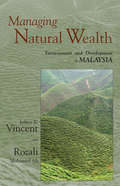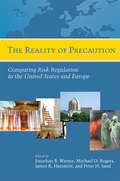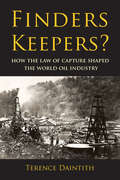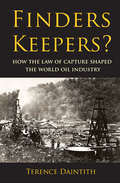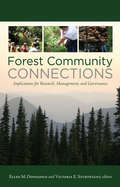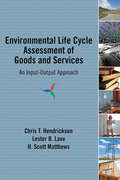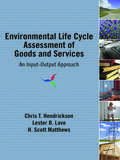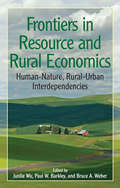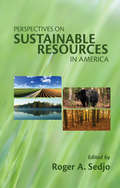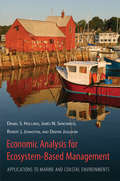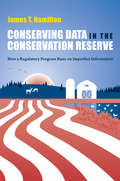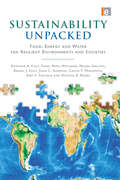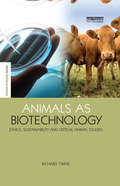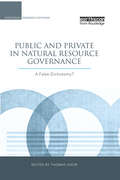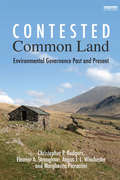- Table View
- List View
Managing Natural Wealth: Environment and Development in Malaysia
by Jeffrey R. Vincent Rozali Professor Mohamed AliThe remarkably rich natural environment of Malaysia attracts the interest of both industry and the environmental community. Managing Natural Wealth analyzes major natural resource and environmental policy issues in the country during the 1970s and 1980s-a period of profound socioeconomic change, rapid depletion of natural resources, and the emergence of serious problems with pollution. Managing Natural Wealth is an important up-date to Environment and Development in a Resource-Rich Economy: Malaysia under the New Economic Policy. First published in hardcover in 1997, this pathbreaking book emphasized economics as a source for analyzing the issues involved in environmental and natural resource management in developing countries. The access that Jeffrey Vincent and Rozali Mohamed Ali and the contributing authors had to unpublished data and key decisionmakers made their account an essential reference for policymakers and researchers in Malaysia and throughout the globe. Managing Natural Wealth includes a review of key developments since the 1990s by S. Robert Aiken and Colin H. Leigh, two geographers with a long-standing interest in environmental change in Malaysia and an understanding of the institutional context of its environmental policy that is unmatched in the scholarly community.
Managing Natural Wealth: Environment and Development in Malaysia
by Jeffrey R. Vincent Rozali Professor Mohamed AliThe remarkably rich natural environment of Malaysia attracts the interest of both industry and the environmental community. Managing Natural Wealth analyzes major natural resource and environmental policy issues in the country during the 1970s and 1980s-a period of profound socioeconomic change, rapid depletion of natural resources, and the emergence of serious problems with pollution. Managing Natural Wealth is an important up-date to Environment and Development in a Resource-Rich Economy: Malaysia under the New Economic Policy. First published in hardcover in 1997, this pathbreaking book emphasized economics as a source for analyzing the issues involved in environmental and natural resource management in developing countries. The access that Jeffrey Vincent and Rozali Mohamed Ali and the contributing authors had to unpublished data and key decisionmakers made their account an essential reference for policymakers and researchers in Malaysia and throughout the globe. Managing Natural Wealth includes a review of key developments since the 1990s by S. Robert Aiken and Colin H. Leigh, two geographers with a long-standing interest in environmental change in Malaysia and an understanding of the institutional context of its environmental policy that is unmatched in the scholarly community.
The Reality of Precaution: Comparing Risk Regulation in the United States and Europe
by James Hammit Michael Rogers Peter Sand Jonathan B. WienerThe 'Precautionary Principle' has sparked the central controversy over European and U.S. risk regulation. The Reality of Precaution is the most comprehensive study to go beyond precaution as an abstract principle and test its reality in practice. This groundbreaking resource combines detailed case studies of a wide array of risks to health, safety, environment and security; a broad quantitative analysis; and cross-cutting chapters on politics, law, and perceptions. The authors rebut the rhetoric of conflicting European and American approaches to risk, and show that the reality has been the selective application of precaution to particular risks on both sides of the Atlantic, as well as a constructive exchange of policy ideas toward 'better regulation.' The book offers a new view of precaution, regulatory reform, comparative analysis, and transatlantic relations.
The Reality of Precaution: Comparing Risk Regulation in the United States and Europe
by James Hammit Michael Rogers Peter Sand Jonathan B. WienerThe 'Precautionary Principle' has sparked the central controversy over European and U.S. risk regulation. The Reality of Precaution is the most comprehensive study to go beyond precaution as an abstract principle and test its reality in practice. This groundbreaking resource combines detailed case studies of a wide array of risks to health, safety, environment and security; a broad quantitative analysis; and cross-cutting chapters on politics, law, and perceptions. The authors rebut the rhetoric of conflicting European and American approaches to risk, and show that the reality has been the selective application of precaution to particular risks on both sides of the Atlantic, as well as a constructive exchange of policy ideas toward 'better regulation.' The book offers a new view of precaution, regulatory reform, comparative analysis, and transatlantic relations.
Finders Keepers?: How the Law of Capture Shaped the World Oil Industry
by Terence DaintithSince the beginnings of the oil industry, production activity has been governed by the 'law of capture,' dictating that one owns the oil recovered from one's property even if it has migrated from under neighboring land. This 'finders keepers' principle has been excoriated by foreign critics as a 'law of the jungle' and identified by American commentators as the root cause of the enormous waste of oil and gas resulting from US production methods in the first half of the twentieth century. Yet while in almost every other country the law of capture is today of marginal significance, it continues in full vigour in the United States, with potentially wasteful results. In this richly documented account, Terence Daintith adopts a historical and comparative perspective to show how legal rules, technical knowledge (or the lack of it) and political ideas combined to shape attitudes and behavior in the business of oil production, leading to the original adoption of the law of capture, its consolidation in the United States, and its marginalization elsewhere.
Finders Keepers?: How the Law of Capture Shaped the World Oil Industry
by Terence DaintithSince the beginnings of the oil industry, production activity has been governed by the 'law of capture,' dictating that one owns the oil recovered from one's property even if it has migrated from under neighboring land. This 'finders keepers' principle has been excoriated by foreign critics as a 'law of the jungle' and identified by American commentators as the root cause of the enormous waste of oil and gas resulting from US production methods in the first half of the twentieth century. Yet while in almost every other country the law of capture is today of marginal significance, it continues in full vigour in the United States, with potentially wasteful results. In this richly documented account, Terence Daintith adopts a historical and comparative perspective to show how legal rules, technical knowledge (or the lack of it) and political ideas combined to shape attitudes and behavior in the business of oil production, leading to the original adoption of the law of capture, its consolidation in the United States, and its marginalization elsewhere.
Forest Community Connections: "Implications for Research, Management, and Governance"
by Ellen M Donoghue Victoria E SturtevantThe connections between communities and forests are complex and evolving, presenting challenges to forest managers, researchers, and communities themselves. Dependency on timber extraction and timber-related industries is no longer a universal characteristic of the forest community. Remoteness is also a less common feature, as technology, workforce mobility, tourism, and 'amenity migrants' increasingly connect rural to urban places. Forest Community Connections explores the responses of forest communities to a changing economy, changing federal policy, and concerns about forest health from both within and outside forest communities. Focusing primarily on the United States, the book examines the ways that social scientists work with communities-their role in facilitating social learning, informing policy decisions, and contributing to community well being. Bringing perspectives from sociology, anthropology, political science, and forestry, the authors review a range of management issues, including wildfire risk, forest restoration, labor force capacity, and the growing demand for a growing variety of forest goods and services. They examine the increasingly diverse aesthetic and cultural values that forest residents attribute to forests, the factors that contribute to strong and resilient connections between communities and forests, and consider a range of governance structures to positively influence the well being of forest communities and forests, including collaboration and community-based forestry.
Forest Community Connections: "Implications for Research, Management, and Governance"
by Ellen M Donoghue Victoria E SturtevantThe connections between communities and forests are complex and evolving, presenting challenges to forest managers, researchers, and communities themselves. Dependency on timber extraction and timber-related industries is no longer a universal characteristic of the forest community. Remoteness is also a less common feature, as technology, workforce mobility, tourism, and 'amenity migrants' increasingly connect rural to urban places. Forest Community Connections explores the responses of forest communities to a changing economy, changing federal policy, and concerns about forest health from both within and outside forest communities. Focusing primarily on the United States, the book examines the ways that social scientists work with communities-their role in facilitating social learning, informing policy decisions, and contributing to community well being. Bringing perspectives from sociology, anthropology, political science, and forestry, the authors review a range of management issues, including wildfire risk, forest restoration, labor force capacity, and the growing demand for a growing variety of forest goods and services. They examine the increasingly diverse aesthetic and cultural values that forest residents attribute to forests, the factors that contribute to strong and resilient connections between communities and forests, and consider a range of governance structures to positively influence the well being of forest communities and forests, including collaboration and community-based forestry.
Environmental Life Cycle Assessment of Goods and Services: An Input-Output Approach
by Chris T. Hendrickson Lester B. Lave H. Scott MatthewsEnvironmental life cycle assessment is often thought of as cradle to grave and therefore as the most complete accounting of the environmental costs and benefits of a product or service. However, as anyone who has done an environmental life cycle assessment knows, existing tools have many problems: data is difficult to assemble and life cycle studies take months of effort. A truly comprehensive analysis is prohibitive, so analysts are often forced to simply ignore many facets of life cycle impacts. But the focus on one aspect of a product or service can result in misleading indications if that aspect is benign while other aspects pollute or are otherwise unsustainable. This book summarizes the EIO-LCA method, explains its use in relation to other life cycle assessment models, and provides sample applications and extensions of the model into novel areas. A final chapter explains the free, easy-to-use software tool available on a companion website. (www.eiolca.net) The software tool provides a wealth of data, summarizing the current U.S. economy in 500 sectors with information on energy and materials use, pollution and greenhouse gas discharges, and other attributes like associated occupational deaths and injuries. The joint project of twelve faculty members and over 20 students working together over the past ten years at the Green Design Institute of Carnegie Mellon University, the EIO-LCA has been applied to a wide range of products and services. It will prove useful for research, industry, and in economics, engineering, or interdisciplinary classes in green design.
Environmental Life Cycle Assessment of Goods and Services: An Input-Output Approach
by Chris T. Hendrickson Lester B. Lave H. Scott MatthewsEnvironmental life cycle assessment is often thought of as cradle to grave and therefore as the most complete accounting of the environmental costs and benefits of a product or service. However, as anyone who has done an environmental life cycle assessment knows, existing tools have many problems: data is difficult to assemble and life cycle studies take months of effort. A truly comprehensive analysis is prohibitive, so analysts are often forced to simply ignore many facets of life cycle impacts. But the focus on one aspect of a product or service can result in misleading indications if that aspect is benign while other aspects pollute or are otherwise unsustainable. This book summarizes the EIO-LCA method, explains its use in relation to other life cycle assessment models, and provides sample applications and extensions of the model into novel areas. A final chapter explains the free, easy-to-use software tool available on a companion website. (www.eiolca.net) The software tool provides a wealth of data, summarizing the current U.S. economy in 500 sectors with information on energy and materials use, pollution and greenhouse gas discharges, and other attributes like associated occupational deaths and injuries. The joint project of twelve faculty members and over 20 students working together over the past ten years at the Green Design Institute of Carnegie Mellon University, the EIO-LCA has been applied to a wide range of products and services. It will prove useful for research, industry, and in economics, engineering, or interdisciplinary classes in green design.
Frontiers in Resource and Rural Economics: "Human-Nature, Rural-Urban Interdependencies"
by Wu JunJie Paul W Barkley Bruce A WeberMost land in the United States is in rural areas, as are the sources of most of its fresh water and almost all its other natural resources. One of the first books to approach resource economics and rural studies as fundamentally interconnected areas of study, Frontiers in Resource and Rural Economics integrates the work of 18 leading scholars in resource economics, rural economics, rural sociology and political science in order to focus on two complex interdependencies-one pertaining to natural resources and human welfare, the other to urban and rural communities and their economies. The book reviews the past 50 years of scholarship in both natural resource and rural economics. It contrasts their different intellectual and practical approaches and considers how they might be refocused in light of pressing demands on human and natural systems. It then proposes a 'new rural economics' that acknowledges the full range of human-ecosystem and urban-rural interdependencies. It explores the relationship between natural resources and economic growth, and considers the prospects for amenity-driven growth that would benefit both new and traditional inhabitants of rural areas. Later chapters explore the politics of place, spatial economics, strategies for reducing rural poverty, and prospects for linking rural and environmental governance. Throughout, the book emphasizes innovative research methods that integrate natural resource, environmental, and rural economics.
Frontiers in Resource and Rural Economics: "Human-Nature, Rural-Urban Interdependencies"
by Wu JunJie Paul W Barkley Bruce A WeberMost land in the United States is in rural areas, as are the sources of most of its fresh water and almost all its other natural resources. One of the first books to approach resource economics and rural studies as fundamentally interconnected areas of study, Frontiers in Resource and Rural Economics integrates the work of 18 leading scholars in resource economics, rural economics, rural sociology and political science in order to focus on two complex interdependencies-one pertaining to natural resources and human welfare, the other to urban and rural communities and their economies. The book reviews the past 50 years of scholarship in both natural resource and rural economics. It contrasts their different intellectual and practical approaches and considers how they might be refocused in light of pressing demands on human and natural systems. It then proposes a 'new rural economics' that acknowledges the full range of human-ecosystem and urban-rural interdependencies. It explores the relationship between natural resources and economic growth, and considers the prospects for amenity-driven growth that would benefit both new and traditional inhabitants of rural areas. Later chapters explore the politics of place, spatial economics, strategies for reducing rural poverty, and prospects for linking rural and environmental governance. Throughout, the book emphasizes innovative research methods that integrate natural resource, environmental, and rural economics.
Perspectives on Sustainable Resources in America
by Roger A. SedjoThe vast size of the United States and extensive variation of its climate, topography, and biota across different regions contribute to both the richness of the nation?s natural heritage and the complexities involved in managing its resources. A follow-up to RFF?s popular America?s Renewable Resources (1990), Perspectives on Sustainable Resources in America updates readers about the current challenges involved in managing America?s natural resources, especially in light of the increasing emphasis on sustainability and ecosystem approaches to management. Written to inform general audiences and students, as well as to engage the interest of experts, the book includes assessments by some of the nation?s most renowned scholars in natural resource economics and policy. An introductory chapter critically examines the concept of sustainability as it has been developed in recent years and asks how the concept might apply to individual resource systems. It considers the interrelatedness of ecosystem, economic, and social sustainability; the paradigms of resource sufficiency and functional integrity; and the contrast between weak and strong sustainability. The chapters that follow examine America?s experience with forests, water, agricultural soils, and wildlife. Highlighting the adaptability and resilience of resource systems, each chapter provides a description of the physical characteristics of the resource, a history of its use, a policy history, and a review of ongoing debates in management and policy. Perspectives on Sustainable Resources in America concludes with an innovative treatment of biodiversity as a natural resource. The chapter reviews the definitions of biodiversity, the ecological and economic meanings of biodiversity, and current efforts to preserve biodiversity, especially through regulatory approaches.
Perspectives on Sustainable Resources in America
by Roger A. SedjoThe vast size of the United States and extensive variation of its climate, topography, and biota across different regions contribute to both the richness of the nation?s natural heritage and the complexities involved in managing its resources. A follow-up to RFF?s popular America?s Renewable Resources (1990), Perspectives on Sustainable Resources in America updates readers about the current challenges involved in managing America?s natural resources, especially in light of the increasing emphasis on sustainability and ecosystem approaches to management. Written to inform general audiences and students, as well as to engage the interest of experts, the book includes assessments by some of the nation?s most renowned scholars in natural resource economics and policy. An introductory chapter critically examines the concept of sustainability as it has been developed in recent years and asks how the concept might apply to individual resource systems. It considers the interrelatedness of ecosystem, economic, and social sustainability; the paradigms of resource sufficiency and functional integrity; and the contrast between weak and strong sustainability. The chapters that follow examine America?s experience with forests, water, agricultural soils, and wildlife. Highlighting the adaptability and resilience of resource systems, each chapter provides a description of the physical characteristics of the resource, a history of its use, a policy history, and a review of ongoing debates in management and policy. Perspectives on Sustainable Resources in America concludes with an innovative treatment of biodiversity as a natural resource. The chapter reviews the definitions of biodiversity, the ecological and economic meanings of biodiversity, and current efforts to preserve biodiversity, especially through regulatory approaches.
Economic Analysis for Ecosystem-Based Management: Applications to Marine and Coastal Environments
by Daniel Holland James Sanchirico Robert Johnston Deepak JoglekaOcean and coastal management regimes are increasingly subject to competing demands from stakeholders. Regulations must not only address fishing, recreation, and shipping, but also sand and gravel mining, gas pipelines, harbor/port development, offshore wind and tidal energy facilities, liquefied natural gas terminals, offshore aquaculture, and desalinization plants. The growing variety and intensity of ocean and coastal uses increases the call for a more holistic, comprehensive, and coordinated management approach that recognizes the often complex relationships between natural and human systems. For both economist and non-economist audiences, this book describes ways in which economic analysis can be an important tool to inform and improve ecosystem-based management (EBM). Topics include modeling economic impacts, benefit-cost analysis, spatial considerations in EBM, incentives and human behaviors, and accounting for uncertainty in policy analysis. Throughout the book the authors elucidate the different kinds of insights which can be gained from the use of different economic tools. In this rigorous and accessible work, the authors defy the conventional stereotype that economic perspectives necessarily favor the greatest commercial development. Instead, they demonstrate how comprehensive economic analyses consider the full range of potential services offered by marine and coastal ecosystems, including the conservation of biodiversity and creation of recreational opportunities.
Economic Analysis for Ecosystem-Based Management: Applications to Marine and Coastal Environments
by Daniel Holland James Sanchirico Robert Johnston Deepak JoglekaOcean and coastal management regimes are increasingly subject to competing demands from stakeholders. Regulations must not only address fishing, recreation, and shipping, but also sand and gravel mining, gas pipelines, harbor/port development, offshore wind and tidal energy facilities, liquefied natural gas terminals, offshore aquaculture, and desalinization plants. The growing variety and intensity of ocean and coastal uses increases the call for a more holistic, comprehensive, and coordinated management approach that recognizes the often complex relationships between natural and human systems. For both economist and non-economist audiences, this book describes ways in which economic analysis can be an important tool to inform and improve ecosystem-based management (EBM). Topics include modeling economic impacts, benefit-cost analysis, spatial considerations in EBM, incentives and human behaviors, and accounting for uncertainty in policy analysis. Throughout the book the authors elucidate the different kinds of insights which can be gained from the use of different economic tools. In this rigorous and accessible work, the authors defy the conventional stereotype that economic perspectives necessarily favor the greatest commercial development. Instead, they demonstrate how comprehensive economic analyses consider the full range of potential services offered by marine and coastal ecosystems, including the conservation of biodiversity and creation of recreational opportunities.
Conserving Data in the Conservation Reserve: How A Regulatory Program Runs on Imperfect Information
by James HamiltonEnrolling over 30 million acres, the U.S. Conservation Reserve Program (CRP) is the largest conservation program in the United States. Under the guidelines of the CRP, the federal government pays farmers to stop farming their land in the hopes of achieving a variety of conservation goals, including the reduction of soil erosion, improvement of water quality, and creation of wildlife habitat. In Conserving Data, James T. Hamilton explores the role of information in the policy cycle as it relates to the CRP. The author asks how the creation and distribution of information about what is going on across these millions of enrolled acres has influenced the development of the program itself. Of the many CRP stakeholders, each accesses a different set of information about the CRP?s operations. Regulators have developed the Environmental Benefits Index as a rough indicator of a field?s conservation benefits and adopted that measure as a way to determine which lands should be granted conservation contracts. NGOs have used publicly available data from these contracts to show how CRP monies are allocated. Members of Congress have used oversight hearings and GAO reports to monitor the Farm Service Agency?s conservation policy decisions. Reporters have localized the impact of the CRP by writing stories about increases in wildlife and hunting on CRP fields in their areas. Conserving Data brings together and analyzes these various streams of information, drawing upon original interviews with regulators, new data from Freedom of Information Act requests, and regulatory filings. Using the CRP as a launch point, Hamilton explores the role of information, including 'hidden information,' in the design and implementation of regulatory policy.
Conserving Data in the Conservation Reserve: How A Regulatory Program Runs on Imperfect Information
by James HamiltonEnrolling over 30 million acres, the U.S. Conservation Reserve Program (CRP) is the largest conservation program in the United States. Under the guidelines of the CRP, the federal government pays farmers to stop farming their land in the hopes of achieving a variety of conservation goals, including the reduction of soil erosion, improvement of water quality, and creation of wildlife habitat. In Conserving Data, James T. Hamilton explores the role of information in the policy cycle as it relates to the CRP. The author asks how the creation and distribution of information about what is going on across these millions of enrolled acres has influenced the development of the program itself. Of the many CRP stakeholders, each accesses a different set of information about the CRP?s operations. Regulators have developed the Environmental Benefits Index as a rough indicator of a field?s conservation benefits and adopted that measure as a way to determine which lands should be granted conservation contracts. NGOs have used publicly available data from these contracts to show how CRP monies are allocated. Members of Congress have used oversight hearings and GAO reports to monitor the Farm Service Agency?s conservation policy decisions. Reporters have localized the impact of the CRP by writing stories about increases in wildlife and hunting on CRP fields in their areas. Conserving Data brings together and analyzes these various streams of information, drawing upon original interviews with regulators, new data from Freedom of Information Act requests, and regulatory filings. Using the CRP as a launch point, Hamilton explores the role of information, including 'hidden information,' in the design and implementation of regulatory policy.
Sustainability Unpacked: Food, Energy and Water for Resilient Environments and Societies
by Kristiina Vogt Toral Patel-Weynand Maura Shelton Daniel J Vogt John C. Gordon Cal Mukumoto Asep. S. Suntana Patricia A. RoadsFood, water and energy form some of the basic elements of sustainability considerations. This ground-breaking book examines and decodes these elements, exploring how a range of countries make decisions regarding their energy and bio-resource consumption and procurement. The authors consider how these choices impact not only the societies and environments of those countries, but the world in general. To achieve this, the authors review the merits of various sustainability and environmental metrics, and then apply these to 34 countries that are ranked low, medium or high on the human development index. The book assesses their resource capacities and the environmental impacts, both within and outside their country boundaries, from consuming food, water, and energy. The final section uses the lessons derived from the earlier analyses of resource consumption to explore the importance of geography, climates and sustainable management of forests and other natural resources for building resilient societies in the future.
Sustainability Unpacked: Food, Energy and Water for Resilient Environments and Societies
by Kristiina Vogt Toral Patel-Weynand Maura Shelton Daniel J Vogt John C. Gordon Cal Mukumoto Asep. S. Suntana Patricia A. RoadsFood, water and energy form some of the basic elements of sustainability considerations. This ground-breaking book examines and decodes these elements, exploring how a range of countries make decisions regarding their energy and bio-resource consumption and procurement. The authors consider how these choices impact not only the societies and environments of those countries, but the world in general. To achieve this, the authors review the merits of various sustainability and environmental metrics, and then apply these to 34 countries that are ranked low, medium or high on the human development index. The book assesses their resource capacities and the environmental impacts, both within and outside their country boundaries, from consuming food, water, and energy. The final section uses the lessons derived from the earlier analyses of resource consumption to explore the importance of geography, climates and sustainable management of forests and other natural resources for building resilient societies in the future.
Animals as Biotechnology: "Ethics, Sustainability and Critical Animal Studies"
by Richard TwineIn Animals as Biotechnology sociologist Richard Twine places the question of human/animal relations at the heart of sustainability and climate change debates. The book is shaped by the emergence of two contradictory trends within our approach to nonhuman animals: the biotechnological turn in animal sciences, which aims to increase the efficiency and profitability of meat and dairy production; and the emerging field of critical animal studies - mostly in the humanities and social sciences - which works to question the nature of our relations with other animals. The first part of the book focuses on ethics, examining critically the dominant paradigms of bioethics and power relations between human and non-human. The second part considers animal biotechnology and political economy, examining commercialisation and regulation. The final part of the book centres on discussions of sustainability, limits and an examination of the prospects for animal ethics if biotechnology becomes part of the dominant agricultural paradigm. Twine concludes by considering whether growing calls to reduce our consumption of meat/dairy products in the face of climate change threats are in fact complicit with an anthropocentric understanding of sustainability and that what is needed is a more fundamental ethical and political questioning of relations and distinctions between humans, animals and nature.
Animals as Biotechnology: "Ethics, Sustainability and Critical Animal Studies"
by Richard TwineIn Animals as Biotechnology sociologist Richard Twine places the question of human/animal relations at the heart of sustainability and climate change debates. The book is shaped by the emergence of two contradictory trends within our approach to nonhuman animals: the biotechnological turn in animal sciences, which aims to increase the efficiency and profitability of meat and dairy production; and the emerging field of critical animal studies - mostly in the humanities and social sciences - which works to question the nature of our relations with other animals. The first part of the book focuses on ethics, examining critically the dominant paradigms of bioethics and power relations between human and non-human. The second part considers animal biotechnology and political economy, examining commercialisation and regulation. The final part of the book centres on discussions of sustainability, limits and an examination of the prospects for animal ethics if biotechnology becomes part of the dominant agricultural paradigm. Twine concludes by considering whether growing calls to reduce our consumption of meat/dairy products in the face of climate change threats are in fact complicit with an anthropocentric understanding of sustainability and that what is needed is a more fundamental ethical and political questioning of relations and distinctions between humans, animals and nature.
Public and Private in Natural Resource Governance: A False Dichotomy?
by Thomas Sikor?This volume develops the rich conceptual and empirical content of public-private relationships, increasingly acknowledged as the dominant realm of natural resource governance. Ten wonderful studies from around the world illuminate opportunities for advancing the theory, analysis and effective formation of sustainable systems of resource use. The book is excellent for courses in governance and public policy in any resource and environmental field.? JEFF ROMM, PROFESSOR FOR RESOURCE POLICY, UNIVERSITY OF CALIFORNIA AT BERKELEY, US ?The book addresses the theoretically and politically most important division of social organization into public and private. The authors bring an exciting, multidisciplinary perspective to bear on changing and multiple publics and the strength of relationships connecting these two spheres in rural development and natural resource governance. The contributions range from consumer health and food safety, soil science, forestry and water management to sociological and economic aspects of natural resource property and governance.? FRANZ VON BENDA-BECKMANN, MAX PLANCK INSTITUTE FOR SOCIAL ANTHROPOLOGY, GERMANY Natural resources have historically been considered as being governed in public or private spheres - that is, by the state on behalf of the people, or by companies or individuals driven by the market. This dichotomy between private and public is now recognized as overly simplistic, and it is clear that ?publics? and ?privates? operate at a range of levels and with differing degrees of separation or overlap. Bringing together a group of internationally respected researchers, this book provides a new perspective on prominent issues in resource governance, including the state, NGOs, civil society, communities, participation, devolution, privatization and hybrid institutions, highlighting the three-dimensional nature of relations between ?public? and ?private?. It builds on empirical analyses from six fields of natural resource governance - agri-environment, biodiversity, bioenergy, food quality and safety, forestry and rural water - and employs a comparative approach that goes beyond the specifi cities of individual policy fields, recognizing shared elements and allowing for a greater understanding of the dynamics underlying governance processes. Introductions to the volume and to each section summarize the key debates and highlight linkages between chapters. This is essential reading for academics, students and policy experts in natural resource governance, development and environmental policy.
Public and Private in Natural Resource Governance: A False Dichotomy?
by Thomas Sikor?This volume develops the rich conceptual and empirical content of public-private relationships, increasingly acknowledged as the dominant realm of natural resource governance. Ten wonderful studies from around the world illuminate opportunities for advancing the theory, analysis and effective formation of sustainable systems of resource use. The book is excellent for courses in governance and public policy in any resource and environmental field.? JEFF ROMM, PROFESSOR FOR RESOURCE POLICY, UNIVERSITY OF CALIFORNIA AT BERKELEY, US ?The book addresses the theoretically and politically most important division of social organization into public and private. The authors bring an exciting, multidisciplinary perspective to bear on changing and multiple publics and the strength of relationships connecting these two spheres in rural development and natural resource governance. The contributions range from consumer health and food safety, soil science, forestry and water management to sociological and economic aspects of natural resource property and governance.? FRANZ VON BENDA-BECKMANN, MAX PLANCK INSTITUTE FOR SOCIAL ANTHROPOLOGY, GERMANY Natural resources have historically been considered as being governed in public or private spheres - that is, by the state on behalf of the people, or by companies or individuals driven by the market. This dichotomy between private and public is now recognized as overly simplistic, and it is clear that ?publics? and ?privates? operate at a range of levels and with differing degrees of separation or overlap. Bringing together a group of internationally respected researchers, this book provides a new perspective on prominent issues in resource governance, including the state, NGOs, civil society, communities, participation, devolution, privatization and hybrid institutions, highlighting the three-dimensional nature of relations between ?public? and ?private?. It builds on empirical analyses from six fields of natural resource governance - agri-environment, biodiversity, bioenergy, food quality and safety, forestry and rural water - and employs a comparative approach that goes beyond the specifi cities of individual policy fields, recognizing shared elements and allowing for a greater understanding of the dynamics underlying governance processes. Introductions to the volume and to each section summarize the key debates and highlight linkages between chapters. This is essential reading for academics, students and policy experts in natural resource governance, development and environmental policy.
Contested Common Land: Environmental Governance Past and Present
by Christopher P. Rodgers Eleanor Straughton Angus J.L. Winchester Margherita PieracciniThis innovative and interdisciplinary book makes a major contribution to common pool resource studies. It offers a new perspective on the sustainable governance of common resources, grounded in contemporary and archival research on the common lands of England and Wales - an important common resource with multiple, and often conflicting, uses. It encompasses ecologically sensitive environments and landscapes, is an important agricultural resource and provides public access to the countryside for recreation. Contested Common Land brings together historical and contemporary legal scholarship to examine the environmental governance of common land from c.1600 to the present day. It uses four case studies to illustrate the challenges presented by the sustainable management of common property from an interdisciplinary perspective - from the Lake District, Yorkshire Dales, North Norfolk coast and the Cambrian Mountains. These demonstrate that cultural assumptions concerning the value of common land have changed across the centuries, with profound consequences for the law, land management, the legal expression of concepts of common 'property' rights and their exercise. The 'stakeholders' of today are the inheritors of this complex cultural legacy, and must negotiate diverse and sometimes conflicting objectives in their pursuit of a potentially unifying goal: a secure and sustainable future for the commons. The book also has considerable contemporary relevance, providing a timely contribution to discussion of strategies for the implementation of the Commons Act of 2006. The case studies position the new legislation in England and Wales within the wider context of institutional scholarship on the governance principles for successful common pool resource management, and the rejection of the 'tragedy of the commons'.
